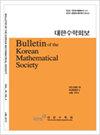生成非跳跃数量的超图
IF 0.5
4区 数学
Q3 MATHEMATICS
引用次数: 5
摘要
跳跃的概念涉及Turán密度的分布。数α∈[0,1]是r的跳跃,如果存在一个常数c > 0,使得r-均匀图的一族F的Turán密度大于α,则F的Turán密度至少为α+c。确定一个数是跳数还是非跳数一直是极值超图理论中一个具有挑战性的问题。本文给出了一种生成超图非跳跃的方法。我们证明了如果α, β分别在r1, r2≥2时是非跳变的,则αβ(r1+r2)!r1 1 R r2 2 r1!r2!(r1+r2) r1+r2对于r1+r2来说是不跳跃的。我们还应用拉格朗日方法来确定3均匀匹配(r−3)倍扩展的Turán密度。本文章由计算机程序翻译,如有差异,请以英文原文为准。
GENERATING NON-JUMPING NUMBERS OF HYPERGRAPHS
The concept of jump concerns the distribution of Turán densities. A number α ∈ [0, 1) is a jump for r if there exists a constant c > 0 such that if the Turán density of a family F of r-uniform graphs is greater than α, then the Turán density of F is at least α+c. To determine whether a number is a jump or non-jump has been a challenging problem in extremal hypergraph theory. In this paper, we give a way to generate non-jumps for hypergraphs. We show that if α, β are non-jumps for r1, r2 ≥ 2 respectively, then αβ(r1+r2)!r r1 1 r r2 2 r1!r2!(r1+r2) r1+r2 is a non-jump for r1 + r2. We also apply the Lagrangian method to determine the Turán density of the extension of the (r − 3)-fold enlargement of a 3-uniform matching.
求助全文
通过发布文献求助,成功后即可免费获取论文全文。
去求助
来源期刊
CiteScore
0.80
自引率
20.00%
发文量
0
审稿时长
6 months
期刊介绍:
This journal endeavors to publish significant research of broad interests in pure and applied mathematics. One volume is published each year, and each volume consists of six issues (January, March, May, July, September, November).

 求助内容:
求助内容: 应助结果提醒方式:
应助结果提醒方式:


